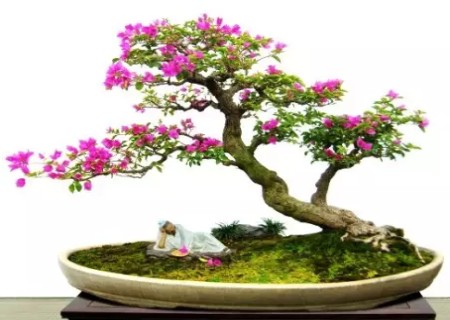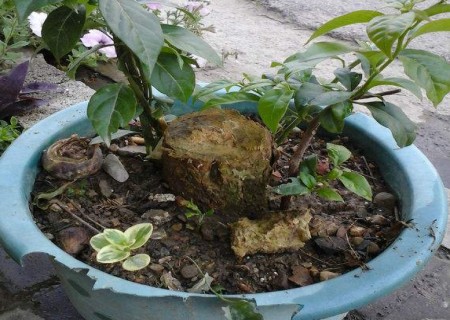Pruning and shaping of Lycium barbarum bonsai
Lycium barbarum stump bonsai posture is elegant, branches overhang, flowers purple, into the autumn red fruit covered with branches, ornamental effect is very good. If you pick leaves in early summer, you can give birth to emerald and green leaves for viewing. Pick the leaves again in early autumn so that the buds and buds are sent out at the same time, so that the ornamental effect of red fruits and new leaves can be seen in late autumn.
Chinese wolfberry bonsai can be reshaped and pruned before planting, and the excessively long roots can be cut short. The main branches of Chinese wolfberry can be properly clambered and pruned. Large branches are suitable for climbing and pruning in winter, while branchlets can be climbed in summer and autumn, mainly with brown silk. At the same time, the diseased branches and dense branches should be cut off, and the sprouting should be removed in time to maintain a certain tree shape. Major pruning and plastic surgery are carried out every winter and spring. The old pile bonsai of Chinese wolfberry should be made into qu dry type or cliff type, the twigs should be tied into drooping shape, and the root shape can be made into bridge type.
In the production practice of cultivating Chinese wolfberry, there is a better pruning method-"happy shape of three main branches". Its advantages are:
1. The crown is formed quickly and fruited early.
2. Good ventilation and light transmission, many fruit branches and high fruit setting rate.
3. The relationship of internal structure is simple and the method is easy to master.
Using this pruning method, a fine single plant will produce five and a half jin of dried fruit at the age of six years. This pruning method is briefly described below.
I. plastic surgery requirements
The first step is to cut the top and set the stem in the first year after planting, and the height of the fixed stem is 50 cm.
In the second step, within the height of 30 cm and 50 cm above the ground, three robust side branches were selected and cultured as three main branches. The selected main branch grows to a certain length and is cut at a distance of 30 cm from the trunk (hereinafter referred to as short shearing). The three main branches should be evenly distributed in three directions and should be staggered up and down. If it is difficult to select a suitable main branch in the first year, you can continue to stay in the second year.
In the third step, the new branches germinated after short pruning of the main branches were treated respectively:
1. Several strong branches near the shearing mouth leave only one elongated branch as the main branch, and the others are cut off.
2. The middle and lower branches (horizontal, drooping, oblique) are retained so that they can develop fruitful branches. From now on, the extension of the main branch will be cut off by 30 cm every year, and the fruit branch will be selected according to the above method.
This kind of tree shape, to sum up, is three main branches and three "heads", one with a bunch of fruit, the fruit branch grows on the main branch, and the chamber is open, ventilated and transparent.
2. Pruning time
Spring pruning will be carried out after mid-April, and the main tasks are:
1. Cut off the needles and wither the shoots
2. Arrange the fruit branches, cut off the transverse branches, cross branches, dense branches, aging diseases and insects, and retain the rest of the fruit branches.
There are two summer pruning, the first in June and the second in July. When pruning in summer, the vigorous growing branches should be dealt with separately, those used to fill the gap in the crown and the "head" extension of the main branch should be retained, and the rest should be cut off. The general budding shoots should be treated as straight and flat, because erect branches grow, do not blossom, do not bear fruit, must be removed, flat branches grow moderately, and most of them are converted into fruiting branches, which should be retained as far as possible.
Autumn is pruned once in September, mainly to cut short and lengthen the "head" of branches to prevent the wind from breaking and rain breaking after autumn.
In the whole process of pruning, you should pay attention to:
1. Keep one main branch and one head. If you leave too many heads, it will cause you to go hand in hand, so that the crown is top-heavy and the branches break.
2. With the increase of seed set, the burden of the main branch is increased, and the angle of the main branch may be too large, which can be corrected by the method of Liuli bud.
Every year, the long branches of the tree from the angle of the rhizome, trunk, and main branches must be removed as soon as possible, and the overgrown branches in the crown should also be cleared as soon as possible to ensure that the inner chamber is open, the three main branches do not shade each other, get sufficient light, and ensure a large amount of fruit.
In addition, the branching ability of Chinese wolfberry is strong, and the new branches grow vigorously. Every year, the old branches should be cut off before germination in early spring, the overgrown branches should be cut off in summer, and the old branches and disease and insect branches should be cut off in autumn. Pruning can reduce diseases and insect pests, enhance ventilation and light transmission, and reduce nutrition consumption. Newly planted Chinese wolfberry seedlings, when the trunk is 60 cm high, go to the top, leaving 3 to 5 lateral branches. In the second year, the selected 3-5 lateral branches were retracted to 30 cm to form the first crown. After that, it will be cultivated year by year to form a three-story "upstairs" tree crown and increase the amount of fruit hanging. If you make bonsai, you can cut off the sturdy branches of Chinese wolfberry before germination in the spring of the following year, and then blossom and bear fruit in the coming year.
Chinese wolfberry has many advantages in making bonsai:
1. Not only the tree shape is beautiful, but also the flowers, fruits, roots, stems, branches and leaves have good ornamental value.
2. It is easy to propagate, and it can be propagated conveniently by means of ramet, pressing, cutting and seed sowing.
3. Chinese wolfberry is a rare good tree species for making small bonsai because of its rapid growth and simple shape.
4. The shape of the fruit is beautiful, the color is as bright as a ruby, and it has a long viewing period.
Time: 2019-06-10 Click:
- Prev

Trimming process of triangular plum bonsai (trimmed picture)
People all want to make the potted flowers not only bloom more, but also want the flowering plant type to look good. Pruning is to achieve the organic combination of potted flowers and bonsai, making the potted flowers of triangular plum a little bonsai meaning, usually you can appreciate the plant type. The editor is going to talk about how to prune potted triangular plums today. The growth period of Prunus mume is long and the growth rate is fast.
- Next

Old Branch cutting technique of Prunus mume with Bonsai Tree stump
Triangular plum is a tropical ornamental flower suitable for beginners to grow. It is relatively easy for friends in the south to raise triangular plum, especially those in the south, who can live if they are randomly planted in the courtyard. You can see the triangular plum growing into a large flower tree in some small courtyards or fences, and even the triangular plum climbing to the fourth or fifth floor.
Related
- Fuxing push coffee new agricultural production and marketing class: lack of small-scale processing plants
- Jujube rice field leisure farm deep ploughing Yilan for five years to create a space for organic food and play
- Nongyu Farm-A trial of organic papaya for brave women with advanced technology
- Four points for attention in the prevention and control of diseases and insect pests of edible fungi
- How to add nutrient solution to Edible Fungi
- Is there any good way to control edible fungus mites?
- Open Inoculation Technology of Edible Fungi
- Is there any clever way to use fertilizer for edible fungus in winter?
- What agents are used to kill the pathogens of edible fungi in the mushroom shed?
- Rapid drying of Edible Fungi

